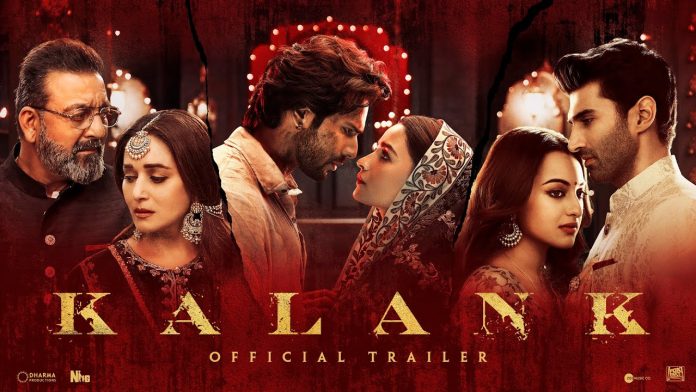Fox Star Studios Pvt. Ltd., Dharma Productions and Nadiadwala Grandson Entertainment Pvt. Ltd.’s Kalank (UA) is a period drama set in India in 1946 just prior to the Britishers leaving India. It is a love story set against the backdrop of the escalating Hindu-Muslim tension in Lahore.
Roop (Alia Bhatt) marries an already married man, Dev Chaudhry (Aditya Roy Kapur), under strange circumstances. Dev is married to Satya (Sonakshi Sinha) who, in fact, welcomes Roop. But Dev tells Roop that since he loves his first wife, she (Roop) should not expect any love in their relationship although she would get all the respect. Dev is the editor of a newspaper which supports industrialisation. He is also in favour of an undivided India. Dev has been living with his wife and father, Balraj Chaudhry (Sanjay Dutt), whom he doesn’t respect at all because the latter had illtreated his (Dev’s) mother. Roop now lives in the same palatial home in Husnabad in Lahore, with Balraj, Dev and Satya.
In the ill-reputed Heera Mandi of Lahore, which is the abode of tawaifs, lives Zafar (Varun Dhawan) who is an ironsmith. He hates Balraj Chaudhry with a vengeance and can do anything to destroy him. Zafar’s bosom pal is Abdul (Kunal Kemmu). Both, Zafar and Abdul, are against the ideology of industrialisation propagated by Dev Chaudhry in his popular newspaper because they fear that industrialisation would render ironsmiths like them jobless.
In Heera Mandi also lives Bahar Begum (Madhuri Dixit), an erstwhile tawaif who now teaches music to students. Roop is enamoured of Bahar Begum’s voice and decides to learn music, about which she has always been passionate, from Bahar Begum. The Chaudhry family is shocked to know that Roop wants to visit Heera Mandi and learn music from Bahar Begum. Although they are not at all happy with her decision, Roop stands her ground and starts to learn music in Heera Mandi under Bahar Begum.
In Heera Mandi, she meets Zafar who already has a girlfriend (Kiara Advani) and who sleeps around with willing girls, without batting an eyelid. Before long, Zafar and Roop have fallen in love with one another. Or have they?
The tension among the Muslims is increasing by the day. Balraj Chaudhry sees red and decides that the family should leave Husnabad as otherwise, the agitated Muslims would not spare them. Since Roop is madly in love with Zafar, she makes an excuse which makes it impossible for the Chaudhrys to leave Husnabad.
And then, the unexpected happens. Balraj and Dev Chaudhry get to know about Roop’s clandestine affair with Zafar. Balraj Chaudhry rushes to Bahar Begum for help. Bahar Begum rushes to Roop to caution her. The tension in the lives of the Chaudhrys is escalating to unimaginable levels both, on the personal as well as professional front. In Roop’s life, there’s a veritable storm which threatens to destroy several people.
What happens thereafter? Why does Balraj Chaudhry go to Bahar Begum for help? What help does he seek from her? Why does Zafar hate Balraj Chaudhry? Why does Bahar Begum rush to Roop? What is it that she wants to caution Roop about? What is Roop’s stance? And what does Zafar want? Do Roop and Dev live happily ever after? Or does Roop accept Zafar as her partner?
Shibani Bathija’s story is interesting and layered but it holds more appeal for the ladies and classes than the menfolk and masses. There are many elements in the story which look very dated and will, therefore, not go down well at all with the youth. Besides, it depends too much on coincidences, something the youngsters will not approve of, more so in serious dramas like this. The circumstances under which Roop marries Dev, the back stories of Bahar Begum, Zafar and Balraj Chaudhry – these are of the kind which used to be seen in films of the 1970s and 1980s but are not very modern thoughts and, therefore, they will not go down too well with the youngsters.
Abhishek Varman’s screenplay is long-winding and looks very laboured rather than free-flowing. The first half, especially, is extremely slow and often gets very boring. Also, several of the things look forced rather than believable. For example, how and why does Roop fall in love with Zafar? But the pre-interval portion does have some very nice moments. Roop going to her own husband’s office for the first time and asking for him is an instance in point. That scene is simply splendid.
The second half is more fast-paced and also more engaging. The scenes between Bahar Begum and Zafar, between Zafar and Dev, between Bahar Begum and Balraj Chaudhry, between Roop and Dev, between Zafar and Balraj Chaudhry, between Roop and Bahar Begum are all interesting and entertaining. The last about 30 minutes of the drama are very good and keep the audience completely engrossed.
If one were to talk of the ingredients of a masala entertainer, the film completely lacks in comedy or humour of any kind. In fact, the film is devoid of light moments, and that’s a big minus point. The entire drama is tension-ridden and even dark. Emotions are few and while the womenfolk may find tears rolling down their cheeks at a couple of places, men may not cry at all.
Hussain Dalal’s dialogues are too verbose and written in flowery language which will be mocked at by the youth of today. A few dialogues are very good.
Varun Dhawan lives the role of Zafar. He looks and plays the frustrated character with a lot of conviction. He is fantastic in the last part. Alia Bhatt delivers yet another memorable performance. Her acting is so outstanding that it wouldn’t be wrong to say, she shines in every scene of hers. She looks a pristine beauty and her costumes and jewellery will become a point of discussion among girls and ladies. But just one point here: why does she dress up more like a Muslim than a Hindu? Madhuri Dixit has done quite well, but she stands out only in dramatic scenes. She has not looked fresh, and her make-up deserves to be condemned. Her dance in the ‘Tabaah’ song is absolutely mind-blowing. Aditya Roy Kapur lends a lot of grace to his performance. He makes a fine impact on the audience. Sonakshi Sinha makes her mark in a brief role as Satya. Sanjay Dutt is just about so-so in the role of Balraj Chaudhry. Kunal Kemmu makes his presence beautifully felt in a special appearance as Abdul. Hiten Tejwani has his moments as Ahmed. Achint Kaur is alright. Kriti Sanon looks fetching and dances beautifully in a song-dance number (‘Aira gaira’). Kiara Advani is okay in a tiny role. Deepak Qazir, Vikram Kapadia and the rest provide decent support.
Abhishek Varman’s direction is fairly good but it also has some glaring shortcomings. He ought to have made a far crisper film. Secondly, he should have made the drama look more believable. In the present form, the scenes don’t create the desired impact. Pritam Chakraborty’s music is hit. The title song is extraordinary. The ‘First class’ number is also very appealing. ‘Tabaah’ and ‘Ghar more pardesia’ are good songs. ‘Aira gaira’ is mass-appealing. Amitabh Bhattacharya’s lyrics are very nice. Song picturisations (by Remo D’Souza, Bosco-Caesar and Saroj Khan) are terrific. The picturisation of the ‘Tabaah’ song (by Saroj Khan and Remo D’Souza) is truly mesmerising. Background music (by Sanchit Balhara and Ankit Balhara) is lovely. Binod Pradhan’s cinematography deserves distinction marks. He has shot the film so beautifully that it looks like a painting. Sham Kaushal’s action scenes and stunts are of a fine order. Amrita Mahal Nakai’s production designing is grand. The sets are not just ostentatious, they are also tasteful. Shweta Venkat Mathew’s editing is quite sharp.
On the whole, Kalank will be liked by women and classes but not by the menfolk and masses. The youth will reject the drama. Considering the huge cast and cost, it will do just about ordinary business at the box-office, thanks in no small measure to lack of Hindi film opposition for the next two weeks. In commercial terms, around 60% of its total investment of Rs. 150 crore has been recovered from sale of satellite, digital and music rights, and recovering of the balance 40% from India and Overseas theatrical revenues may not be a problem. But just reaching the break-even point in a grand and big-budgeted film like this is surely not enough. Put differently, one doesn’t make such a costly film to just get the investment back or earn a mere 2-5% return on investment.
Released on 17-4-’19 at Regal (daily 4 shows) and other cinemas of Bombay thru Shringar Films Pvt. Ltd. Publicity: extraordinary. Opening: excellent at many places, considering that it was released on an odd day (Wednesday) which wasn’t a major holiday (Mahavir Jayanti). …….Also released all over. Opening was superb at places, and very good at others, considering the fact that it was an odd-day release. But collections fell sharply on the second day.





























